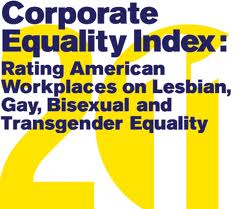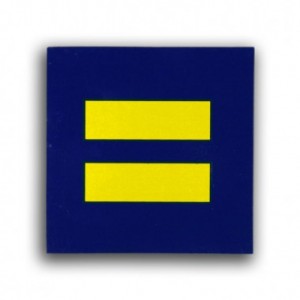Since 2002 the Human Rights Campaign has been creating and releasing a public Corporate Equality Index each year. This is a list of businesses and corporations that indicates their level of LGBT support and equality in terms of employment. Businesses are chosen from the Fortune Magazine’s 1000 largest publicly traded  businesses and the American Lawyer Magazine’s top 200 revenue grossing law firms and then invited to take part in equity surveys and cross checks. Other private sector businesses with at least 500 full time employees and is not owned by a larger entity can request an invite as well. Each company is rated on a scale of 0 to 100 on how equally they treat their LGBT employees, consumers, and investors.
businesses and the American Lawyer Magazine’s top 200 revenue grossing law firms and then invited to take part in equity surveys and cross checks. Other private sector businesses with at least 500 full time employees and is not owned by a larger entity can request an invite as well. Each company is rated on a scale of 0 to 100 on how equally they treat their LGBT employees, consumers, and investors.
The HRC has developed a list of criteria on how each business is rated. These include evaluating a company’s written policy of nondiscrimination based on sexual orientation, gender expression, and gender identity; inclusion of sexual orientation, gender identity, and gender expression in its diversity and sensitivity training; parity in domestic partner benefits; appropriate and respectful advertising to the LGBT community; transgender-inclusive health insurance benefits; rejection of any activities that would undermine the goal of equal rights for LGBT people. These aspects decide where on the 0 to 100 scale a company will fall.
After requesting or receiving an invite, companies must have one person fill out a survey created by the HRC. This in depth questionnaire asks questions such as, “does your health insurance contract have a definition of spouse?” and “Does your primary non-discrimination or equal employment opportunity policy include the term “gender identity or expression” or “gender identity“?” The 36 pages of questions are specific and direct, and is unlikely to be falsified by any company. Likewise, HRC researchers routinely perform cross checks to verify survey answers.
Here is a video that tells more about the CEI and its impact.
As expected, an ongoing debate revolves around the effect that the index list has on a company’s success. Some proclaim that participation boosts public popularity for those that score well; others believe that the more conservative side will pull their business away from those companies. Even so, the HRC has seen huge progress since the beginning of the CEI. In just one year, company policies saw a 92% increase in their inclusion of transgender discrimination protection. If I’m not mistaken, that’s a pretty huge jump over a short 12 month period. What’s more, companies that have received  bad ratings have gotten some pretty negative publicity over the years. Because of this, they have been more focused on improving their LGBT policies.
bad ratings have gotten some pretty negative publicity over the years. Because of this, they have been more focused on improving their LGBT policies.
Along with the CEI, the Human Rights Campaign has developed a Buyer’s Guide. Essentially, the guide is a tool to help consumers aim their shopping at LGBT supportive companies, and spend less or none of their money at low scoring stores or businesses. The guide can be accessed in a handful of different ways. Anyone can go online to use the Buyer’s Guide in a simple and straightforward way by searching for companies and viewing their scores and analysis. For example, by searching “Starbucks,” I can see that their rating is 90, and that one of their low points is that they do not offer “equal health coverage for transgender individuals without exclusion for medically necessary care.” Besides accessing the guide online, consumers can choose to download a copy of the guide, receive a virtual copy, use the iPhone app, or by using the text on the go feature.
I think that the CEI is an excellent way to push for LGBT equality within the workplace. Not only does it create competition for companies to rank higher on the list each year, but it promotes business and equality. Often times, people will even start shopping at a store that they had never been to before, simply because the company supports equality. When consumers know that they are putting money toward a good cause, they’re more likely to spend it. The CEI is a complete win-win situation in my opinion, and I think that the list should be publicized and used more than it currently is. I want all consumers to be aware of what they’re supporting when they decide to buy a new pair of shoes or a serving of chicken nuggets. I, for one, have completely stopped spending money at certain establishments due to their harsh policies, and I think that everyone else should do the same. I want everyone to be educated and aware of where they shop and how they spend their money. By easily utilizing the variety of ways to access the Buyer’s Guide, we can all push toward greater equality nationwide. So, when will you start shopping smart? How about now?


